For centuries, Kinmen attracted immigrants. An early name for the island was Xianzhou (仙洲) — the land of immortals. While locals claim this refers to Taiwu, the island’s highest peak, said to resemble a reclining deity, it suggests a favorable living environment. Indeed, Kinmen was once flush with verdure. The island’s deforestation was attributed to Zheng Chenggong’s (鄭成功, also known as Koxinga) shipbuilding drive in the mid-17th century, but this was merely the shedding of the undergarments in an enforced, centuries-long striptease.
Heavy logging began during the Yuan Dynasty (1294-1307) when salt production on the island required large quantities of timber. A vestige of this industry, which petered out as mechanization took hold in the late 1980s, has been preserved in the salt fields of Xiyuan (西園), a tourist attraction in the northeast of the island. During the Ming, Japanese marauders exacerbated things — at one stage holding the island hostage for 50 days, during which time they turned their blades to the local populace. Zheng’s forces completed the denudement.
The result was exposure to sandstorms and monsoons. Bare and bleak, a once enticing haven had become a forbidding outpost. Compelling immigrants to return to China’s Fujian Province, an anti-Ming edict of 1679 compounded the isolation. Farmers and fisherman were replaced by pirates and bandits, who terrorized villages, ransacking houses and piling their vessels with plunder, before bolting back to Xiamen. The evolution of the island’s wind lion gods dates to this period. Positioned around the island, these statues were erected to repel brigands as much as storms.
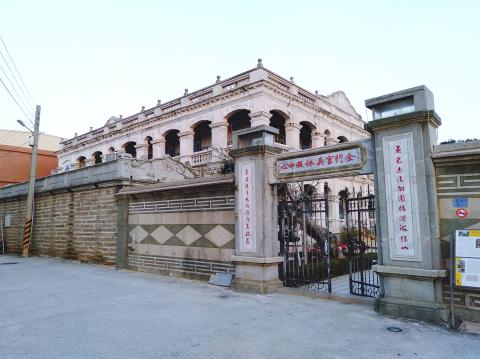
Photo: James Baron
“The pirates kept coming until World War II, when Japan occupied Kinmen,” says Chen Mei-ling (陳美玲), a guesthouse owner in the village of Bishan (碧山) on the east coast. “So, people had to defend themselves,” she adds, recalling tales of elderly relatives organizing armed patrols. “Life in Kinmen was tough.”
DISTRUST OF OUTSIDERS
With villages established along clan lines tracing to ancestral hometowns in Fujian Province, distrust and hostility extended to all outsiders.
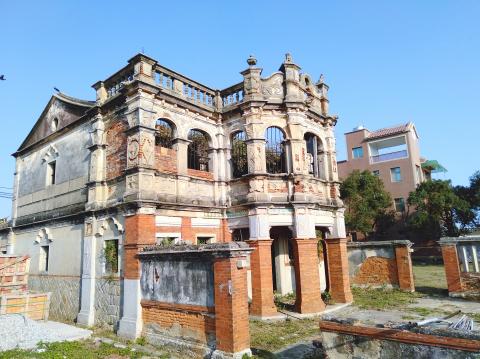
Photo: James Baron
“In the old days, you couldn’t even enter a neighboring village,” says Chen, who works as a nurse at Kinmen’s only hospital. “Can you see the secret hiding place up there?” she asks, motioning to the ceiling in the main room of the accommodation — one of the many immaculately maintained traditional abodes for which Kinmen is renowned. “No? Exactly!”
In the courtyard, a discerning eye can spot entrances to the hidey-holes where, says Chen, family “treasures” were stowed. Yet, such safeguards were insufficient for some. Around Kinmen are buildings incorporating more stringent protective measures coupled with ostentatious foreign flourishes. They are a testament to a generation of Kinmenese who took wing on the winds that had propelled their forebears to the island. Their destination was Nanyang (南洋) — literally the “South Seas” but akin to “Southeast Asia.” Yet, no English rendering does justice to the Chinese term, which conveys El Dorado-esque notions of unfettered opportunity that could not be enjoyed in China.
“In addition to a barren living environment and lack of materials, there were political reasons for emigration,” says Lin Chin-jung (林金榮), a local historian. “These included high taxes and restrictions that made it hard for traders to prosper in China.”
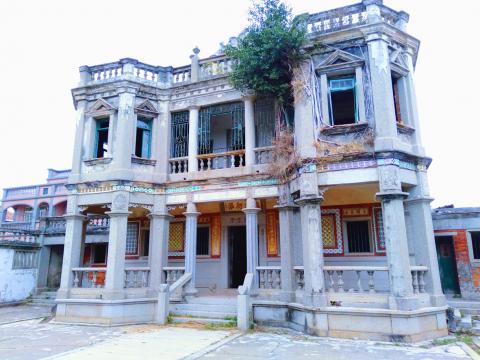
Photo: James Baron
At the village of Shuitou (水頭), close to Kinmen’s main port, is a revealing indicator of what overseas Kinmenese accomplished and their preoccupation with the welfare of their kinsfolk back home. Completed in 1931, the Deyue Tower (得月樓) is the centerpiece of a collection of buildings commissioned by the Huangs (黃), merchants who found fortune in Indonesia. Advertising the affluence and sophistication of the clan, the tower also fulfilled a practical function. Two pairs of embrasures on the upper floors allowed defenders to take pot-shots at intruders and escape passages connected to the adjoining houses.
Just as a single clan name is associated with most villages in Kinmen, so too are the overseas locations where success was achieved. For the Hsuehs (薛) of Zhushan (珠山), an inland village three kilometers southeast of Shuitou, the Philippines was the land of plenty. Zhushan features a pair of yanglou (洋樓) — the term used for occidental-style buildings — fortified with towers and ramparts. One of these impressive red brick structures is now a B&B.
TRAILBLAZING CLANS
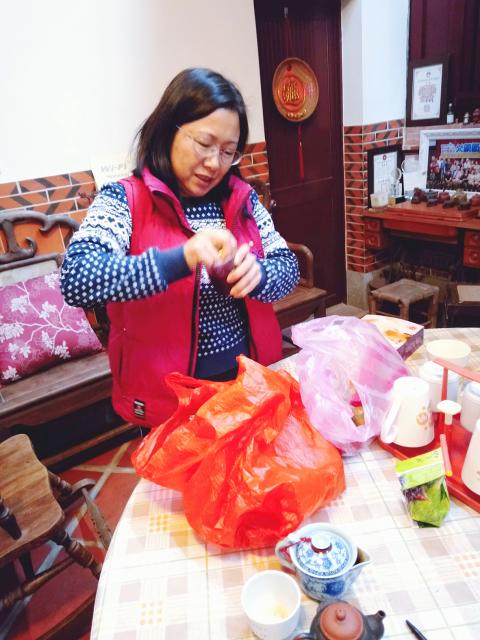
Photo: James Baron
Starting from the lowliest positions, trailblazing clan members would establish themselves in a region before relatives followed in their footsteps.
“Working as coolies, doing labor such as hauling goods from ship to harbor, they saw what goods were being imported and figured out was profitable,” Lin says. “When they had saved enough money, they would open their own business, starting small but gradually expanding as they gained experience.”
As they prospered, the effect of their remissions to the home villages drew attention. The yanglou became targets for pirates, so the inclusion of defensive elements was natural. Those without towers or walls, were built on natural vantage points, and several were commandeered by both the Japanese and the Chinese Nationalist Party (KMT) militaries.
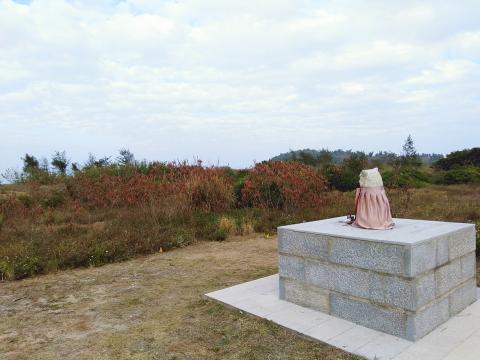
Photo: James Baron
One example is the island’s largest yanglou, Chen Jing-lan Western House (陳景蘭洋樓), perched on a knoll at Chenggong (成功), just east of the airport. With its exquisitely carved colonnade, this mansion was built on a sugar and soap empire. Chen also funded a waterfront pavilion for local fishermen and the nearby Shang Ching Watch Tower, a small sentry fort using leftover materials from the mansion. Constructed in 1921, the mansion later became a military hospital and leisure center. A dusty billiards table sits next door to a recreated medical facility at the back of the house. On the second floor are biographies of prominent Kinmenese emigres.
Like many overseas Kinmenese, Chen became a patron of education, sponsoring schools in Singapore and his homeland. Following military sequestration, the mansion for a time housed Kinmen High School. Similar concerns can be seen in Bishan, where the Juiyou School (睿友學校) was established with a bequeathment from a Singapore-based timber merchant. Chen Jui-you (陳睿友) expressed a desire to provide the formal learning that he had lacked — a common theme among Kinmen’s benefactors. Alas, with the onset of war, the school was seized by Japanese forces in 1937, shortly after its completion. Occupied by the KMT as a Communist invasion loomed in 1949, it didn’t fulfill its intended use until the 1960s.
With marble imported from China, kapur from the rainforests of Southeast Asia and an elaborate gable featuring KMT emblems alongside Chinese cranes and Sikh guards sounding bugles, Juiyou School perfectly encapsulates the Kinmenese odyssey: Chinese business savvy, tropical luxury and British colonial opportunity. Found on a building in this obscure, windswept village, the combination of motifs is perfectly eccentric.
Chen Jui-you’s posthumous wishes were carried out by a younger cousin, Chen De-hsing (陳德幸), whose own contribution to Bishan stands near the entrance to the village. Currently in a ruinous state, it nonetheless offers a striking blend of Occident and Orient: the front half comprises a red-brick portico topped by an ornate baroque facade while the back features a typically Hokkien swallow-tail roof.
ECCENTRIC EMIGRES
Dating to 1931, Chen Ching-chi’s (陳清吉) residence, at the other end of the village, is in a decidedly better state of repair. An architrave at the entrance is engraved with the English words “Union is Strength.” Variations of the motto have been used on flags and crests over the centuries, including the coat of arms for the Federation of Malaya. Though this was not formed until 1948, the design derived from an earlier British flag and it’s likely that an emblem somewhere in British Malaya was the inspiration for the motto.
Having secured wealth as a trader in rubber and spices, Chen Ching-chi returned to Kinmen for the building’s completion, which coincided with his son’s marriage to a daughter of the Cai (蔡) clan, a notable family from Cyonglin (穹林), one of Kinmen’s wealthiest and best preserved townships.
On the edge of the gated walls of Chen Ching-chi’s yanglou is the guesthouse run by his great-niece, Chen Mei-ling. Out front is a large clay oven with a shiny aluminum flue and bundles of brushwood stacked underneath. A scraggly rose bush overlooks a low marble table where a pair of small rice bowls dries on lotus leaves lining a wicker tray. To the left, a narrow entrance leads to the enclosed courtyard, where a bamboo rocking chair creaks, jostled by the bluster that penetrates from above.
The wooden doors to the main room are propped open by a pair of chairs. It’s hard to imagine those bygone bandit country days. As with most parts of the island, theft is now unheard of here. In front of the ancestral altar, among pots of homemade roselle jam and packets of gongtang (貢糖) — a type of crumbly peanut cookie — a fascinating book sits on the round table.
Kinmen Eminent Persons in History (金門先賢錄) is published by the Singapore Branch of the Kim Mui Hoey Kuan (金門會館), the association for overseas Kinmenese, it contains biographies of prominent emigres and their descendants.
First is Ong Sam Leong (王三龍), who struck gold supplying labor for phosphate mines in the late 19th century and whose sons later partnered with Shaw Brothers — of kung-fu flick fame — to run popular amusement parks. Also featured is Helen Yeo Hee Neo (楊喜娘), a prominent social activist, descended from Guanao (官澳), at the northernmost tip of Kinmen. The daughter of a British-born industrialist, she married Sir Song Ong Siang (宋旺相), a brilliant legal scholar and the first Chinese to receive a knighthood. Another luminary with Kinmen roots was Lim Yew Hock (林有福), chief minister of Singapore ahead of independence.
Flicking through these pages, one is struck by the outsized influence of Kinmen’s emigres. Yet, as living standards improved post World War II, the exodus subsided. Ironically, while civilians and architecture suffered during the 20-year bombardment by the Chinese Communists, nature thrived under a reforestation program designed to provide cover for the Nationalist forces. Despite the ravages of Typhoon Meranti, which local reports say uprooted 5 million trees in 2016, Kinmen is surprisingly arboreal. Birders are drawn from far and wide by the variety of species.
Still, things appear to have come full circle. While Taiwan’s government touts a New Southbound Policy, Kinmenese are casting glances back toward Fujian.
“Xiamen is now much richer than Kinmen,” says Chen Mei-ling. Most of her guests are from China and, where they were once impressed by the relative affluence, “they now come for the peace and quiet.”
There is ambivalence about dependence on Chinese tourism, but also resignation. Like their leonine guardians, the Kinmenese are used to looking outward to see what the winds portend.
“What can we do?” asks Chen. “We have to survive.”

June 23 to June 29 After capturing the walled city of Hsinchu on June 22, 1895, the Japanese hoped to quickly push south and seize control of Taiwan’s entire west coast — but their advance was stalled for more than a month. Not only did local Hakka fighters continue to cause them headaches, resistance forces even attempted to retake the city three times. “We had planned to occupy Anping (Tainan) and Takao (Kaohsiung) as soon as possible, but ever since we took Hsinchu, nearby bandits proclaiming to be ‘righteous people’ (義民) have been destroying train tracks and electrical cables, and gathering in villages

Swooping low over the banks of a Nile River tributary, an aid flight run by retired American military officers released a stream of food-stuffed sacks over a town emptied by fighting in South Sudan, a country wracked by conflict. Last week’s air drop was the latest in a controversial development — private contracting firms led by former US intelligence officers and military veterans delivering aid to some of the world’s deadliest conflict zones, in operations organized with governments that are combatants in the conflicts. The moves are roiling the global aid community, which warns of a more militarized, politicized and profit-seeking trend

The wide-screen spectacle of Formula One gets a gleaming, rip-roaring workout in Joseph Kosinski’s F1, a fine-tuned machine of a movie that, in its most riveting racing scenes, approaches a kind of high-speed splendor. Kosinski, who last endeavored to put moviegoers in the seat of a fighter jet in Top Gun: Maverick, has moved to the open cockpits of Formula One with much the same affection, if not outright need, for speed. A lot of the same team is back. Jerry Bruckheimer produces. Ehren Kruger, a co-writer on Maverick, takes sole credit here. Hans Zimmer, a co-composer previously, supplies the thumping

Dr. Y. Tony Yang, Associate Dean of Health Policy and Population Science at George Washington University, argued last week in a piece for the Taipei Times about former president Ma Ying-jeou (馬英九) leading a student delegation to the People’s Republic of China (PRC) that, “The real question is not whether Ma’s visit helps or hurts Taiwan — it is why Taiwan lacks a sophisticated, multi-track approach to one of the most complex geopolitical relationships in the world” (“Ma’s Visit, DPP’s Blind Spot,” June 18, page 8). Yang contends that the Democratic Progressive Party (DPP) has a blind spot: “By treating any